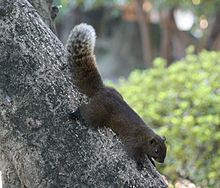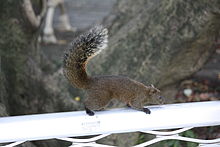Pallas squirrel
| Pallas squirrel | ||||||||||||
|---|---|---|---|---|---|---|---|---|---|---|---|---|

Striking but well hidden: the red belly |
||||||||||||
| Systematics | ||||||||||||
|
||||||||||||
| Scientific name | ||||||||||||
| Callosciurus erythraeus | ||||||||||||
| ( Pallas , 1779) |
The Pallas's Squirrel ( Callosciurus erythraeus ) or Mexican gray squirrel is a representative of Real callosciurinae ( Callosciurus ).
features
Pallas squirrels reach a head-trunk length of up to 20 cm, the bushy tail almost doubles the length of the animal. The numerous subspecies of the Pallas squirrel are very variable in their characteristics, both in the body mass and the color of the fur, and it is difficult to formulate a uniform description of the characteristics. The variability goes so far that the numerous subspecies can only be distinguished from other, very similar, species of the genus with difficulty due to their variety of shapes and show strong overlapping of features.
As a rule, the Pallas squirrel is inconspicuously olive-green on the back. The belly is clearly reddish in color, whereby this color can range from chestnut brown to bright red to light cream-orange. The animals have strong claws on their fingers and toes, the knuckles of which are extremely rotatable, which enables them to climb trees quickly. Thanks to the position of their large eyes, the Pallas squirrels can also look back without turning their head.
Habitat and Distribution
The Pallas squirrel is native to central and eastern southern China , including the islands of Hainan and Taiwan , and large parts of mainland Southeast Asia from Vietnam to Bangladesh and northern India .
The Pallas squirrel has now also been spread by humans in France and Belgium (since 2005). Other countries to which the Pallas squirrel was introduced are Argentina , Japan and the Netherlands . The Pallas squirrels may be a threat to the red squirrels ( Sciurus vulgaris ) native to Europe .
The Pallas squirrel was added to the “List of Unwanted Species” for the European Union in 2016.
Way of life
The natural habitat of the Pallas squirrels are the tops of subtropical mountain forests, in China also of subalpine coniferous and mixed forests. But they can also be found on trees in city parks.
nutrition
The croissants are also considered to be important seed dispersers for various tree species. In addition to seeds, grains, nuts and fruits, Pallas squirrels also feed on insects.
Reproduction and development
Pallas squirrels have alternating sexual partners. When the females are ready to conceive, several males gather around them and start calling. Then the males start fighting each other. The victor will then often guard the female for a while after mating to ensure that he will become the father of the offspring. If the number of challengers becomes too high, however, it can happen that the guard gives up and other males come into play. The female builds a nest for the offspring during the spring and autumn whelping season. After the boys are born, they are looked after until they are self-employed.
Pallas squirrels lived up to 17 years in captivity.
Taxonomy and systematics
Initial description and assignment
The Pallas squirrel Callosciurus erythraeus is classified as an independent species within the genus of the real beautiful squirrel ( Callosciurus ), which consists of 15 species. The first scientific description as Sciurus erythraeus comes from Peter Simon Pallas from 1779, who probably described an individual from Assam , India ; the exact area ( terra typica ) is unknown and the type no longer exists. The first assignment to the genus Callosciurus , described by John Edward Gray in 1867 , was not made until 1916 by Oldfield Thomas and Robert Charles Wroughton , who also described several subspecies. Since the first description, there have been numerous other descriptions of species and subspecies as well as classifications. Lurz et al. 2013 lists according to more than a hundred synonyms of the species, including two synonyms under the generic name Herpestes that due to a mismatch to the corresponding Mangustengattung came about.
Species delimitation and subspecies
The concrete taxonomic differentiation from other species and the subdivision into subspecies is currently under discussion. Above all, Callosciurus erythraeus flavimanus is often (also here) regarded as a subspecies, while some processors also regard it as a separate species. Today, in addition to the nominate form Callosciurus erythraeus erythraeus, numerous other subspecies are distinguished within the species . A total of about 26 to 30 subspecies are confirmed:



- Callosciurus erythraeus erythraeus
- Callosciurus erythraeus atrodorsalis
- Callosciurus erythraeus bartoni
- Callosciurus erythraeus bhutanensis
- Callosciurus erythraeus bonhotei
- Callosciurus erythraeus castaneoventris
- Callosciurus erythraeus erythrogaster
- Callosciurus erythraeus flavimanus
- Callosciurus erythraeus gloveri
- Callosciurus erythraeus gordoni
- Callosciurus erythraeus griseimanus
- Callosciurus erythraeus harringtoni
- Callosciurus erythraeus hendeei
- Callosciurus erythraeus hyperythrus
- Callosciurus erythraeus intermedius
- Callosciurus erythraeus michianus
- Callosciurus erythraeus ningpoensis
- Callosciurus erythraeus pranis
- Callosciurus erythraeus rubeculus
- Callosciurus erythraeus shanicus
- Callosciurus erythraeus siamensis
- Callosciurus erythraeus sladeni
- Callosciurus erythraeus styani
- Callosciurus erythraeus thai
- Callosciurus erythraeus thaiwanensis
- Callosciurus erythraeus zimmeensis
etymology
The scientific name of the genus Callosciurus is made up of the Greek words "callo" for "beautiful", "skia" for "shadow" and "oura" for "tail". The species name erythraeus refers to the red color of the belly of the nominate form.
Threat and protection
The Pallas squirrel is classified by the International Union for Conservation of Nature and Natural Resources (IUCN) as least concern due to its large distribution area, the large populations and the unknown threat to the population. It also occurs in numerous protected areas and is very adaptable to changes in its habitat.
supporting documents
- ^ JC Moore, GHH Tate: A study of the diurnal squirrels, Sciurinae, of the Indian and Indochinese subregions. Fieldiana: Zoology 48, 1965; P. 101 ff. ( Full text )
- ↑ a b c d e Peter WW Lurz, Virginia Hayssen, Kimberly Geissler, Sandro Bertolino: Callosciurus erythraeus (Rodentia: Sciuridae) . In: Mammalian Species . tape 45 , no. 902 , 2013, p. 60-74 , doi : 10.1644 / 902.1 .
- ↑ a b c d Encyclopedia of Life: Callosciurus erythraeus
- ↑ Darrin Lunde, Robert S. Hoffmann, Andrew T. Smith: Pallas's Squirrel. In: Andrew T. Smith , Yan Xie: A Guide to the Mammals of China. Princeton University Press, Princeton NJ 2008, ISBN 978-0-691-09984-2 , p. 183.
- ↑ a b c d e Callosciurus erythraeus in the Red List of Threatened Species of the IUCN 2013.2. Listed by: JW Duckworth, RJ, Timmins, S. Molur, 2008. Retrieved January 25, 2014.
- ↑ Invasive species in Belgium
- ↑ UNEP World Conservation Monitoring Center: Review of Callosciurus erythraeus and Sciurus niger, November 2010. Study for the European Commission Directorate General Environment ENV.E.2. - Environmental Agreements and Trade, November 2010 (PDF; 242 kB)
- ↑ List of Invasive Alien Species of Union Concern (PDF) accessed on July 15, 2016
- ↑ a b c Callosciurus erythraeus In: Don E. Wilson , DeeAnn M. Reeder (Ed.): Mammal Species of the World. A taxonomic and geographic Reference. 2 volumes. 3. Edition. Johns Hopkins University Press, Baltimore MD 2005, ISBN 0-8018-8221-4 .
literature
- Peter WW Lurz, Virginia Hayssen, Kimberly Geissler, Sandro Bertolino: Callosciurus erythraeus (Rodentia: Sciuridae) . In: Mammalian Species . tape 45 , no. 902 , 2013, p. 60-74 , doi : 10.1644 / 902.1 .
- Richard W. Thorington Jr., John L. Koprowski, Michael A. Steele: Squirrels of the World. Johns Hopkins University Press, Baltimore MD 2012; Pp. 137-139. ISBN 978-1-4214-0469-1
- Darrin Lunde, Robert S. Hoffmann, Andrew T. Smith: Pallas's Squirrel. In: Andrew T. Smith , Yan Xie: A Guide to the Mammals of China. Princeton University Press, Princeton NJ 2008, ISBN 978-0-691-09984-2 , p. 183.
Web links
- Callosciurus erythraeus onthe IUCN Red List of Threatened Species 2013.2. Listed by: JW Duckworth, RJ, Timmins, S. Molur, 2008. Retrieved January 25, 2014.


